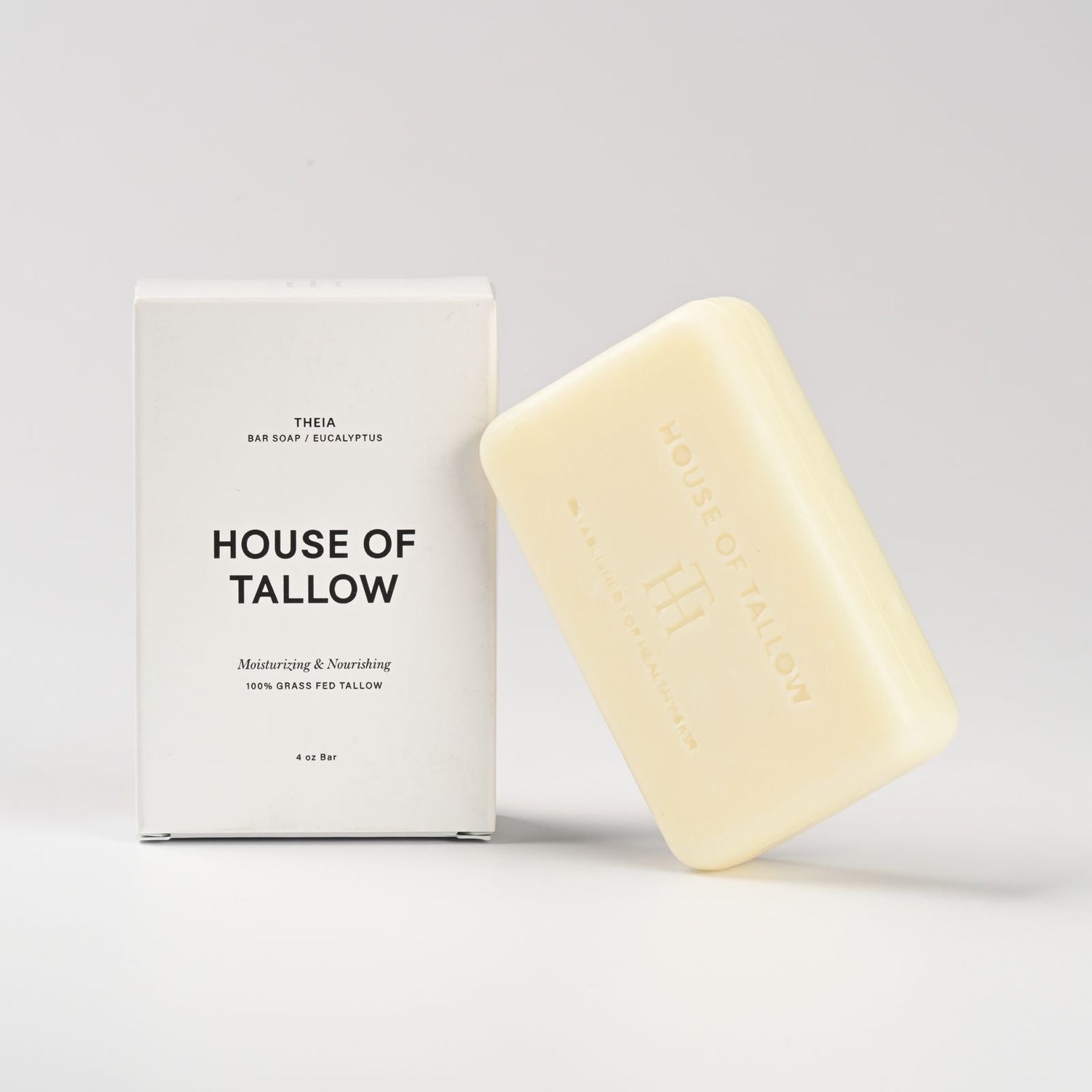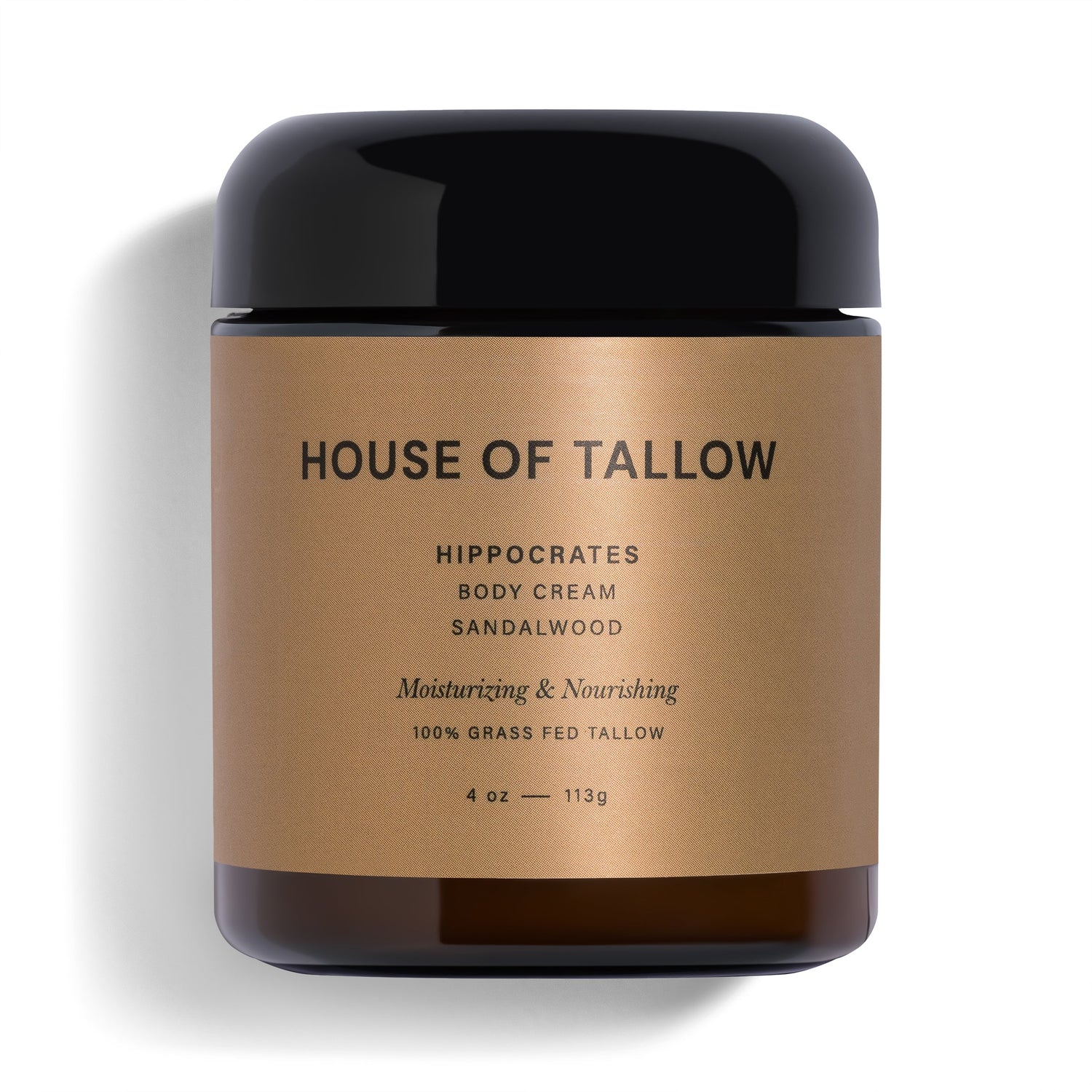Grass-fed tallow is a skincare powerhouse. Its fatty acid composition closely mimics human skin, making it highly effective for hydration, barrier repair, and inflammation reduction. Here's why it's unique:
- Balanced Omega Ratio (1.4:1): Promotes skin health and reduces inflammation.
- High Saturated (50.4%) & Monounsaturated Fats (46.3%): Excellent for moisturizing and skin repair.
- Low PUFA (1.9%): Increases stability and shelf life.
-
Key Fatty Acids:
- Oleic Acid (37.55%): Enhances absorption and calms irritation.
- Palmitic Acid (27.45%) & Stearic Acid (17.45%): Lock in moisture and improve elasticity.
- Alpha-Linolenic Acid (0.8%): Supports healing and reduces inflammation.
Compared to grain-fed tallow, grass-fed tallow has 4x more omega-3s, 45% fewer PUFAs, and a skin-friendly lipid profile. Its natural pH (~5.5) and non-comedogenic properties make it ideal for sensitive and dry skin, as seen in products like House of Tallow's creams for infants and adults.
Main Fatty Acids in Grass-Fed Tallow
Stearic and Palmitic Acids
Stearic acid works as a protective emollient, while palmitic acid closely resembles the lipids found in human skin. Together, these saturated acids create a stable foundation for skincare products, offering long-lasting hydration. They help lock in moisture and support skin repair and elasticity, making them essential components in many formulations.
Oleic Acid Properties
Oleic acid is a standout fatty acid in grass-fed tallow. As a monounsaturated fat, it not only provides deep hydration but also improves the skin’s ability to absorb other compounds effectively.
| Property | Skin Benefit |
|---|---|
| Enhanced Absorption | Helps the skin take in other beneficial compounds |
| Barrier Support | Strengthens the skin's natural lipid barrier |
| Anti-inflammatory | Calms irritation and reduces redness [3] |
| Antioxidant | Protects the skin from free radical damage |
Omega-3 and Omega-6 Balance
The balance of omega-3 and omega-6 fatty acids in grass-fed tallow promotes skin health by reducing inflammation and maintaining the skin's natural moisture barrier [2][3]. This balance makes it particularly suitable for sensitive skin, as seen in products like those from House of Tallow, which are designed with these benefits in mind.
Grass-Fed Beef Tallow: The Ultimate Natural Fat
Grass-Fed vs. Grain-Fed Tallow Analysis
Research from the University of Illinois highlights key differences in fatty acid composition between grass-fed and grain-fed tallow [1]. Grass-fed tallow contains 0.8% omega-3 alpha-linolenic acid - four times more than its grain-fed counterpart - making it particularly useful for addressing skin inflammation, as noted in the Oleic Acid Properties section.
PUFA and Omega-3 Content
Grass-fed tallow stands out due to its lower levels of polyunsaturated fatty acids (PUFAs), which are essential for improving formulation stability. At the same time, it offers higher omega-3 content, a combination that benefits both product performance and skin health [1].
| Fatty Acid Component | Grass-Fed Tallow | Grain-Fed Tallow |
|---|---|---|
| Omega-6 Linoleic | 1.1% | 3.25% |
| Omega-3 Alpha-Linolenic | 0.8% | 0.2% |
Skin Health Benefits
Lower PUFA levels in grass-fed tallow enhance oxidative stability, which helps extend shelf life without compromising product effectiveness. This stability aligns with traditional skincare practices that prioritize the use of stable fats [1].
Grass-fed tallow’s high oleic acid content allows for better skin penetration, making it especially suitable for dry or sensitive skin. Its composition closely mimics human sebum, improving compatibility and effectiveness in skincare formulations designed for delicate or compromised skin.
sbb-itb-a1b9fc0
Skincare Uses of Grass-Fed Tallow
Grass-fed tallow is known for its skin-friendly lipid composition, which allows it to absorb more effectively than many plant-based alternatives. This unique structure makes it an excellent ingredient for targeted skincare products addressing specific needs.
Sensitive Skin Products
Thanks to its anti-inflammatory properties, grass-fed tallow is often used in products designed for sensitive skin. Here's how it works for various skin concerns:
| Skin Condition | How It Helps |
|---|---|
| Eczema/Psoriasis | Supports barrier repair |
| Pregnancy-related dryness | Helps improve skin elasticity |
| Infant skin | Provides gentle barrier support |
| Aging skin | Aids in collagen maintenance |
Its non-comedogenic properties, due to stable saturated fats, make it a great moisturizer that won't clog pores. Additionally, its natural pH of around 5.5 closely matches the skin's acidity, which helps reduce the chance of irritation [2]. This balance is a result of its natural fatty acid composition.
House of Tallow Product Line

House of Tallow incorporates cold-processed tallow into their body creams and baby care products to maintain its bioactive benefits. Two standout products include:
- Gaia (Unscented) Tallow Body Cream: Ideal for locking in moisture and strengthening the skin barrier.
- Tallow Baby Cream: Gentle enough for infants, offering protective hydration.
For best results, apply to clean skin to boost moisture retention and create a protective barrier.
Summary
Grass-fed tallow offers a unique fatty acid profile, featuring a balanced omega-6 to omega-3 ratio (1.4:1) and a high concentration of skin-friendly saturated and monounsaturated fats. These qualities make it an excellent choice for supporting skin barrier function and managing inflammation.
In skincare, this ingredient is prized for its natural compatibility with human skin. Stearic acid in tallow helps lock in moisture and provides a softening effect, while oleic acid improves absorption and strengthens the skin’s barrier. Additionally, alpha-linolenic acid plays a role in reducing inflammation and promoting healing.
The close resemblance between the lipids in grass-fed tallow and those in human skin explains its effectiveness in restoring hydration and repairing the skin barrier. This makes it a key ingredient in many natural skincare products.
FAQs
What fatty acids are in grass-fed beef?
Grass-fed tallow contains a mix of fatty acids that are beneficial for skincare:
- Oleic acid (37.55%): Helps improve absorption.
- Palmitic acid (27.45%): Supports the skin's protective barrier.
- Stearic acid (17.45%): Acts as a moisturizing agent.
It also has a balanced omega-6 to omega-3 ratio of 1.4:1 [1], which contributes to its anti-inflammatory properties. With only 1.9% polyunsaturated fatty acids (PUFAs), it remains stable and reduces inflammation. Additionally, conjugated linoleic acid (CLA) offers further anti-inflammatory benefits [1].




